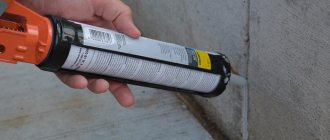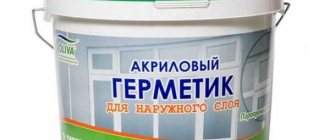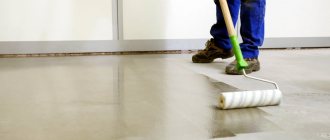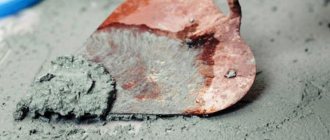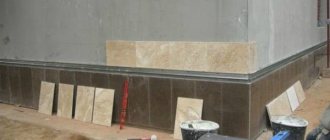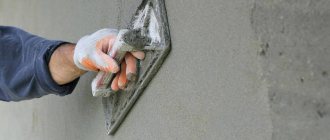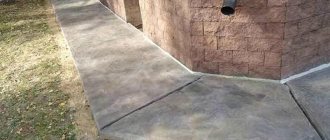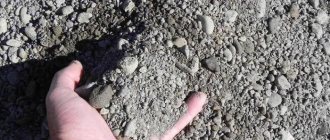Whatever type of construction work you carry out, the sealing stage inevitably comes, which makes cracks and joints impenetrable to moisture, cold and atmospheric influences and protects building structures from mold and mildew. But for each type of work you need to select a suitable sealant.
Where one sealant works perfectly, another may be useless.
If you select even the best quality sealant incorrectly, it can quickly peel off, turn black, and begin to leak moisture. Thus, time, money and effort will be wasted.
In this article, Sika technicians explain how to select sealants for interior and exterior applications according to the required application.
Independent installation of a waterproof expansion joint with a metal profile
The construction of expansion joints in concrete floors can be carried out using a special metal profile, which is important in industrial premises.
How to make a waterproof seam with a metal profile:
- A long plaster rule or string is used to mark a line for cutting grooves 20-30 wide and up to 4 centimeters deep (corresponding to the height of the metal profile).
- Cutting the seam with a wall chaser (several at once, followed by cutting out the concrete with a hammer drill and cleaning with a cylindrical grinder).
- Carrying out level control using a laser level.
- Filling the bottom of the seam with a layer of reinforced polymer concrete, finishing the surface.
- Inserting special bolts into the profiles, installing them in the correct position, connecting two profiles into a solid structure with fixation with nuts and connecting elements. The distance between the profiles can be different; it is indicated in the project, taking into account the type of expansion joint. Make sure that the bottom plane of the profiles lies without distortions in any direction. The profile fits into place without effort. At the joints of the profiles there is a guide rod and a hole, which guarantee the strength of the connection of several elements into one structure. Before joining, the elements can be coated with high-quality metal glue.
Fastening the profile with dowels, drilling holes of the required diameter on wide horizontal planes according to the size of the plastic elements of the dowels. The approximate depth of the hole that is drilled should be 2-3 centimeters greater than the length of the dowel, then it will be easier to drive it in. Screwing the metal elements of the dowels all the way with an electric drill, checking the quality of fixation. Dowels are attached in increments of 40-50 centimeters. Dismantling the installation kit - removing the nuts and metal tie, which is secured with bushings with internal threads. After unscrewing, the bolts do not need to be cut off, since they are located below the upper plane of the profiles and in the future a decorative insert will be attached to them
On the profiles you also need to unscrew the nuts that temporarily fix the bolts. Laying an elastic replaceable insert: a roll is rolled out along the profile (starting from the end), carefully pressed into the seating protrusions until it stops. The insert should lie flat, without gaps or distortions; the remaining piece is cut off with a mounting knife. Installation of decorative overlays made of stainless alloy steel (most often used for loaded floors) or aluminum
The surface of the pads includes the ends of the mounting bolts. Everything is fixed with nuts, the position is adjustable, eliminating gaps between adjacent elements. Next you need to remove the protective film. Installing a protective cover on the profile (it is removed after the coating has hardened).
.
Types of expansion joints
In practice, two types of cuts are used:
- insulating
- they are installed along the walls of the room to prevent the effect of deformation of the building envelope on the concrete floor. They are created using insulating material, which is laid around the perimeter of the room; - shrinkage
- they are intended to prevent the appearance of cracks during the hardening of concrete mortar screeds.
Wherein:
- Areas with an elongated layout or L-shape should be avoided;
- the length cannot exceed the width of the blocks by more than 1.5 times;
- cuts should be made straight without branches.
No. 2. Acrylic sealants: properties and scope of use
Acrylic sealants are a mixture of acrylate polymers and are used primarily for interior work . Can be painted with acrylic paints or varnishes in any color.
Acrylic sealants are:
- non-waterproof . They are odorless, completely environmentally safe, and hardly tolerate deformation, so they are best used on surfaces that are not subject to thermal expansion. It is used when repairing furniture, window frames, as well as when working with dry walls made of plasterboard and concrete. If moisture gets on such compounds, it will quickly damage the sealant;
- waterproof compounds have high adhesion to almost all types of surfaces, incl. brick, concrete, tiles, PVC and plasterboard. Can be used in bathrooms and kitchens, but not in swimming pools. If the sealant will be used in the bathroom, it is advisable that the composition contains antifungal components.
All types of acrylic sealants have the following advantages :
- good adhesion to brick, concrete, plaster, wood, tiles and other surfaces;
- the ability to maintain original properties over a wide temperature range (from -20 to +600C);
- environmental friendliness and the absence of harmful fumes, so you can work with such sealants without personal protective equipment;
- resistance to ultraviolet rays;
- ease of operation;
- price. Costs 1.5-2 times lower than silicone sealants. Transparent acrylic sealants are considered the most expensive.
Flaws:
- with prolonged exposure to low temperatures, elasticity is lost;
- In terms of moisture resistance, acrylic sealants are inferior to their analogues, so for rooms with a consistently high level of humidity it is better to choose other compositions.
Acrylic sealants are usually sold in 300-500 ml tubes, applied directly from the tube or using a special gun. Already 15 minutes after application they form a film, and finally harden after 24 hours.
Scope of application : filling seams and cracks in stone and concrete surfaces, boards, window and door frames, filling voids around communication pipes, sealing joints in bathrooms and kitchens, less often in bathrooms.
Methods of protection
Before you begin waterproofing work, you need to choose the appropriate method
It is important to take into account some criteria:
it is important to determine the depth and width of the seam; take into account possible loads on it; take into account the peculiarities of the construction of the building and its subsequent operation.
Seam waterproofing can be carried out during the construction of the structure, during operation, as well as during repair work. During the construction of a structure, certain types of seam sealing work are carried out:
- a special membrane is formed at the seam site;
- waterstops are carefully fixed;
- the seam is filled with sealant;
- A special elastic tape is fixed on the structure to improve the quality of sealing.
During the operation of the building, as well as during repairs, certain work is envisaged to improve the quality of seam insulation and prevent depressurization.
The seams are filled with special sealants or similar materials with increased elasticity. Seams are also filled using acrylic or polyurethane resins. For this purpose, the injection method of waterproofing is used. Then elastic bands and waterstops are carefully secured to the joints.
Waterproofing materials and methods of their use
There are many materials and methods for waterproofing concrete. The choice of a suitable solution will depend on the location of application, the processing area, the intensity of use, and the possible budget.
Concrete waterproofing options:
- penetrating waterproofing for concrete;
- concrete additives for waterproofing;
- liquid waterproofing for concrete;
- coating waterproofing for concrete;
- glued or built-on waterproofing;
- sealant for concrete.
Penetrating waterproofing
Flexible membrane for waterproofing seams
This material is used when the seam width is large enough. The membrane is secured with metal clamping strips to the concrete edges. Before this, the recess should be treated with a sealant with a high degree of adhesion. Waterproofing of cold joints is carried out using this material.
The negative side of this method is that it is impossible to apply it when bottom waters are close to each other. For greater strength, you can use a casing and penetrating waterproofing that is coated over the concrete, making it waterproof. It is worth noting that if microscopic cracks appear in the material, the integrity of the waterproofing will be compromised, and additional insulation work will have to be carried out. Waterproofing of expansion joints is carried out using embedded rubber or polyurethane profiles. First you need to install a waterproofing key , which is laid at the time of pouring the monolith. To do this, special insert elements are mounted into the formwork, with the help of which an expansion joint is subsequently formed, inside of which there is a key.
Different types of dowels are used, it all depends on the impact the environment will have on the expansion joints. In order to make waterproofing even better, special grades of concrete that are highly waterproof are used. There is a special membrane waterproofing of seams, which is used as an alternative solution to the above-described method of sealing expansion joints between slabs.
How to seal seams: step-by-step diagram
Expansion joints also serve as “bridges” of cold; they must be sealed in order to reduce the thermal conductivity of the concrete screed. Sealing must be carried out strictly according to the rules, while not forgetting about thorough surface preparation.
Tools and equipment
For work, you should purchase a suitable sealant, deep penetration primer, as well as tools:
- narrow spatula for leveling the composition;
- priming brush;
- sealant gun.
Construction guns for applying sealant and attachments for them
The gun is selected depending on the packaging of the purchased product: there are universal models, devices for sealants in tubes, cartridges, “sausages” or for bulk products. Professionals often use special equipment for high-precision and continuous supply of sealants, which is very important for large processing areas.
Surface preparation
Having carried out the correct preparation, you can be confident in the high quality of adhesion of the sealant to the concrete. The coating must be durable. If its areas are crumbling, it is worth cleaning them and treating them with concrete mixture locally, and only after drying do sealing.
During the preparatory activities, remove all debris (with a broom, brush or vacuum cleaner, blow out the cracks with compressed air), rid the surface of traces of corrosion, rot, and mold. Be sure to degrease and remove old paint on which the sealant does not adhere well. Entrenched contaminants are removed by grinding and sandblasting.
Cleaning joints in concrete screed
Highly porous concrete is treated with a solvent to remove residual dust, microfilms, and preservatives. The presence of defects, holes, chips, depressions is unacceptable - they must be carefully repaired.
Cracks that are too narrow, on the contrary, are carefully widened. At the end of preparation, the surface is treated with a primer with a high concentration of active components. The treatment area should exceed the sealant application boundaries by at least 3–4 cm on each side.
Preparation of the composition
Single-component products are directly packaged and simply inserted into the gun, as they require no preparation. In two-component compositions, paste and hardener are combined in the proportions specified by the manufacturer. The ratio must not be violated, otherwise the sealant will turn out hard or will not be able to harden. Stir the material for 3–5 minutes until a homogeneous mass is obtained. If the composition is too thick, it can be diluted with gasoline or white spirit (80 ml per 1 kg).
Preparation of a two-component composition for use
Technology for applying curing sealants
It is better to apply the product from a gun, but if you don’t have one, you can use a regular spatula. Fill cracks in the floor, evenly distributing the composition along the entire length of the seam. After this, moisten a narrow spatula in soapy water and level the sealant flush with the floor. Excess is immediately removed.
During work, it is necessary to take into account that the sealant begins to harden over a certain period of time. For example, acrylic compounds begin to cure after 15 minutes; on polyurethane compounds, a durable film appears after 1 hour. If the plastic characteristics of the mass have decreased, it will be difficult to apply it, and the quality of the seam may decrease. Complete drying of sealants usually takes at least a day, after which the floor will be ready for use.
Technology for applying non-curing compounds
Such sealants are applied in a similar way using metal syringes, wooden or iron spatulas, and hoses. Some products must be heated to +30...+50 degrees before use, as indicated in the instructions. The operating temperature of the joints should not be higher than +70 degrees, and the joints themselves should be sealed from above with cement-sand mortars to increase the tightness.
Filling joints in a concrete floor with a construction syringe
Post-processing
As the seam dries, it can be plastered, sprinkled with cement or sand in a layer of 1–2 mm. Some sealants can be painted if required.
Sealing
The next step after cutting ditches in concrete is sealing them. High-quality sealing is necessary in order to protect the screed from moisture penetration deep into the concrete, as well as to prevent other damage.
There are several options for how to carry out this work:
- use of special sealant - due to its elasticity, mastics are very easy to work with. In addition, they give a good effect and reliably protect concrete from water penetration;
- sealants - the use of various sealing materials is also quite popular. They are especially well suited for making insulation slots;
- special slats are another sealing option. Such strips consist of a metal profile and a rubber lining and can be installed both in fresh concrete and in grooves made after it has dried.
Compensation bar
Whatever method is chosen, it will protect concrete floors only if the work technology is followed
Therefore, it is always important to take your time and follow the manufacturer's instructions
Necessary materials
A seam is a cut in the structure of a building. During the sealing process, it is filled with a special material.
Creating seam waterproofing is a painstaking and responsible process, so only proven and high-quality building materials are used for it. Most often used for this:
- Soil mixtures. They contain quartz sand, cement and various special chemical components.
- Waterproofing materials. During construction work, very often minor defects are left unattended, which can lead to negative consequences: the appearance of mold, dampness on the ceiling and walls inside the building. To eliminate them, waterproofing building materials are used.
- Very often, special hydraulic seals are used to eliminate and prevent leaks.
- An excellent option for seam sealing is waterproofing cords. When in contact with moisture, they tend to swell, thereby filling the space and eliminating any leaks. However, it should be noted that this material is only a suitable option for small seams.
- To optimally protect a building from moisture, waterproofing dowels are often used. They also perfectly compensate for the mobility of the structure.
- Special sealants.
To produce this type of waterproofing, special rubber and the latest technologies are used. Highly durable and waterproof, waterstops come in a variety of shapes and sizes, allowing you to choose the right option for any seam.
What products do we offer?
The joints of elements in any structure are the most vulnerable. Therefore, we suggest purchasing polyurethane sealant for sealing joints in concrete (shrinkage, deformation, temperature). Our catalog also includes the following solutions:
expanding waterproofing tape;
vinyl ester methacrylate gel;
joint waterproofing systems;
elastic one-component moisture-resistant sealant;
silicone compounds for sealing joints between tiles;
primer for preparing surfaces before sealing.
We offer a mixture for joints in concrete and sealing joints produced by the German concern Master Builders Solution at affordable prices. You can also take a closer look at products from other brands in our catalog.
MasterSeal 910 (MasterFlex 610)
Expanding waterproofing tape for construction and construction joints of reinforced concrete structures subject to pressure water pressure.
MasterSeal 909 (MasterFlex 900)
Injection hose with the ability to re-inject structural and technological joints of reinforced concrete structures
MasterSeal 901 (MasterFlex 801)
Vinyl ester methacrylate gel for injection of cracks and seams of structures through injection hoses and packers
MasterSeal 930 (MasterFlex 3000)
System for waterproofing seams for various purposes.
MasterSeal 912 (MasterFlex 612 W)
One-component polymer paste that expands upon contact with water for waterproofing structural and cold joints
MasterSeal NP 474 (MasterFlex 474)
One-component, elastic, moisture-resistant joint sealant
PCI Elastoprimer 110
Primer for preparing the base when sealing joints
PCI Silcoferm VE
Silicone sealant for sealing joints between tiles or tiles and structures exposed to constant exposure to water (swimming pools, water parks, fountains, bathtubs, as well as balconies and terraces).
MasterSeal CR 460 and MasterSeal P 460
Liquid two-component colored polyurethane sealant and primer composition.
PCI Silcoferm S
Silicone sealant for sealing joints between tiles or joints between tiles and adjacent structures exposed to short-term exposure to water in showers, kitchens, toilets, residential and commercial premises.
WaboCrete II
An elastomeric material intended for the construction and repair of expansion joints.
MasterSeal 440
Polyurethane one-component elastomeric joint sealant with low modulus of elasticity
MasterSeal CR 171 – MasterSeal CR 170
Highly effective chemical resistant two-component polysulfide based joint sealant
MasterSeal CR 171 – bulk version, MasterSeal CR 170 – thixotropic version of the sealant
Kinds
There are several types of sealants on sale for expansion joints in concrete, which differ in chemical composition: silicone, silicate, thiokol, etc. In addition to chemical properties, acriplast must be waterproof and frost-resistant.
Acrylic
Acrylic sealant is less resistant to sudden changes in temperature and humidity, so it is best used for internal treatments of concrete areas that do not require serious protection. Acriplast has good vapor permeability.
After application, a smooth film is formed. This type is used to align the connecting parts between walls, ceilings, and floors.
Acrylic sealant does not contain solvents, so the dried surface can be subjected to subsequent processing (painting, varnishing).
Polyurethane
Polyurethane sealant for joints in concrete is a waterproof product that is suitable for sealing joints, while ensuring the strength and service life of the screed. For ease of application, a construction syringe is used, which will direct the flow of acryplast, avoiding flowing down a vertical plane. Since the polyurethane product is able to withstand temperature changes and the effects of humidity, it can be used for external seams. The connection is strong after the permissible load has completely dried.
Polyurethane components allow the compound to withstand exposure to chemicals, oils, alkalis and other difficult elements. Based on their composition, they are divided into one-component and two-component.
Two-component polyurethane sealants are prepared in accordance with the dosage prescribed in the instructions. Deviation from it will lead to loss of properties of the connection.
Silicone
Silicone sealant is demanding when preparing the work area. The connection that will be processed must be thoroughly cleaned of dirt, dust and primed. Fulfilling these requirements will ensure high adhesion.
The material is produced single-component, multi-component, with a rubber base.
The advantages of raw materials include:
- thixotropy;
- contains no solvents;
- pasty consistency;
- after drying, a film forms;
- the mass, under the influence of air humidity, penetrates into the seam;
- the resulting seam is elastic, not susceptible to chemical or water influence, and durable.
Thiokols
Thiokol mixture is an elastic sealant made from polysulfides. They give the mass the properties of flexibility, resistance to the effects of oils, alkalis, saline solutions, etc. These are two-component compositions.
The prepared mixture is similar to flexible rubber; it does not shrink when dried. The seam is protected from deformation due to temperature changes and aggressive environmental influences.
Silane modified
Sealants of this type have increased flexibility, which depends on the content of silane-modified polymers in the base. The composition does not include solvents, which makes it possible to use in rooms with high humidity. The dried surface can be processed and painted.
The advantage is plasticity, not fluidity, which is important when sealing vertical concrete planes. Also, the seam will have long-lasting performance properties, is not exposed to direct sunlight, and is resistant to chemicals
Butyl rubber
Butyl rubber acryplast is a one-component composition that contains solvents. Manufactured from synthetic rubber elastomers. The dried layer forms a film that resists chemical and weather influences and at the same time retains all its properties.
No primer is required for strong adhesion.
Using products from the MasterSeal line, you can solve a number of problems during construction and during repairs: external and internal underground waterproofing of buildings, sealing of junctions of structures and seams, installation of chemically resistant waterproofing protection of structures, roofing waterproofing, internal waterproofing of tanks for various purposes.
Moreover, all materials comply with regulatory documents SP 250.132580 and GOST 32017.
Primers
Polymer compositions designed to prepare the surface and increase adhesion before applying polymer waterproofing membranes.
MasterSeal P 385 - epoxy-cement composition for leveling and priming surfaces
MasterSeal P 770 is a high-component primer based on Xolutec™ technology for MasterSeal M-series membranes
MasterSeal P 681 is a two-component epoxy-based primer for steel surfaces without solvents, with 100% solids residue
MasterSeal P 684 is a one-component, solvent-containing primer for stainless steel or non-ferrous metal surfaces.
MasterSeal P 690 is a one-component polyacrylate-bitumen primer for the MasterSeal Traffic 2301 system
MasterSeal P 691 is a one-component, solvent-containing, non-pigmented polyurethane-based primer for polymer substrates
Hot-applied polyurethane and hybrid waterproofing membranes
MasterSeal M 800 is a two-component elastic waterproofing membrane based on polyurethane for mechanical application
MasterSeal M 811 is a two-component elastic waterproofing membrane based on a polyurea hybrid
Polymer chemically resistant waterproofing membranes
MasterSeal M 338 is a two-component water-based rigid epoxy coating for waterproofing and protecting reinforced concrete structures.
MasterSeal M 790 is a two-component, crack-bridging membrane based on Xolutec™ technology
MasterSeal M 808 is a two-component plastic polyurethane membrane for waterproofing
Finish coatings for polymer membranes
Polyurethane-based polymer compositions, usually applied next after the main layer. They perform additional coating functions, such as, for example, protecting the base layer from UV radiation or imparting decorative properties, etc.
MasterSeal TC 258 is a one-component colored polyurethane composition with high weather resistance
MasterSeal TC 268 is a low-viscosity, two-component polyurethane varnish with low solvent content.
MasterSeal TC 269 is a two-component tintable polyurethane composition with high weather resistance
Cement waterproofing coatings
MasterSeal 501 is a cement-based penetrating composition for compacting the concrete structure
MasterSeal 525 is a two-component elastic polymer-cement membrane for waterproofing reinforced concrete and stone structures
MasterSeal 531 is a one-component mineral-based waterproofing coating
MasterSeal 588 is an elastic polymer-cement coating for waterproofing and protecting reinforced concrete and stone structures
MasterSeal 590 is an ultra-fast-hardening cement mixture for eliminating active water leaks in concrete and masonry
MasterSeal 6100 FX is a one-component elastic polymer-cement coating for concrete protection and waterproofing, light gray and white.
Contact sheet waterproofing membrane MasterSeal 754 with components
MasterSeal 754 is a roll membrane for waterproofing foundations, providing complete adhesion to the concrete surface
MasterSeal 754 IC - internal corner node self-adhesive element for installation
MasterSeal 754 OC - external corner self-adhesive element
MasterSeal 934 is a waterproofing installation tape based on FPO with one adhesive surface
MasterSeal 935 - double-sided adhesive tape based on butyl rubber
Bitumen-polymer waterproofing
MasterSeal 612 - one-component bitumen-polymer emulsion mastic
MasterSeal 620 is a one-component bitumen-polymer emulsion mastic with a high solid content in the residue
MasterSeal 645 is a two-component water-based bitumen-polymer emulsion with mineral filler for waterproofing
Nodal waterproofing materials
MasterSeal 901 - vinyl ester methacrylate gel for injection of cracks and seams of structures through injection hoses and packers
MasterSeal 909 is an injection hose with the ability to re-inject structural and technological seams in reinforced concrete structures
MasterSeal 912 is a one-component polymer paste that expands upon contact with water for waterproofing structural and cold joints.
MasterSeal 930 / MasterSeal 933 - a system for waterproofing and sealing seams, cracks, and junctions of structures, consisting of TPO-based tape
Sealing materials
One-component or two-component polymer-based compositions for elastic filling of seams, joints, connections in building structures
MasterSeal NP 474 is a one-component elastic moisture-resistant joint sealant
MasterSeal 440 is a polyurethane one-component elastomeric sealant for seams with a low modulus of elasticity
MasterSeal HY 495 is a one-component joint sealant based on MS polymer with a low modulus of elasticity
MasterSeal 473 RC is a polyurethane one-component, high-modulus, fast-hardening elastomeric joint sealant
Injection protection
This method of waterproofing various seams is one of the newest and most effective technologies for protecting a building from moisture penetration. It is used to restore and protect structures in the most inaccessible places. This method allows you to perform seam sealing without opening the finish.
The essence of this technology is to pump waterproofing solutions into the seams using a special injection pump. At the same time, even minor cracks and seams are filled evenly due to high pressure and a certain consistency of the solution. Polymerization of the material occurs within a few minutes.
In some cases, the use of epoxy resins is allowed. This material is most effective for restoring the mechanical integrity of a building structure. Epoxy resins have excellent adhesive properties and allow you to repair various damage to either cold external or always warm internal surfaces. But the connection made using such material turns out to be quite rigid, which does not always correspond to the operating conditions of expansion joints.
The process of waterproofing by injection is presented more clearly in the following video.
Classification of sealants
Acriplast is classified into groups according to defining characteristics:
- Method of influence on the treated base: surface elements form a protective moisture-proof cover, and in-depth impact compositions fill the concrete pores inside, preventing moisture from passing through.
- According to the component formula, mixtures for interpanel seams and joints for interior work are distinguished, with increased flexibility, thiokol materials. Each of the materials has its own properties and characteristics.
- Single-component sealants and binary mixtures that require specific mixing. They have different degrees of flexibility, drying periods, and strength indicators.
When buying a sealant for cracks in concrete, you need to take into account the scope of application of the material: indoor or outdoor treatment, screed made recently or a long time ago. Basically, such sealants are universal and have good adhesion to wood, metal and other surfaces.
We recommend videos on the topic:
No. 9. What must be taken into account when choosing a sealant?
Naturally, before going to the store, you need to clearly understand where and under what conditions the sealant will be used. If it is a bathtub, then a moisture-resistant composition is required; if it is a wooden floor, then the sealant must be elastic and not contain solvents. In addition, pay attention to what is indicated on the packaging:
- area of application of the composition (external or internal work);
- type of work performed (roofing, window, plumbing, etc.);
- the manufacturer must indicate for what types of surfaces the sealant is intended, as well as whether it is elastic or not;
- composition color. If the sealant cannot be painted or simply will not be painted, its color is important so that aesthetics are not compromised;
- sealants can be household or professional, the latter are more difficult to use;
- pay attention to the indicated operating temperatures of the composition, comparing them with the existing climate characteristics in the region.
Concrete waterproofing: rigid, elastic, polymer. For interior and exterior use.
Concrete is perhaps the most popular building material, providing the ability to erect buildings and structures for various purposes and withstand various loads. This material is used in the construction of underground structures, and in the construction of high-rise buildings, and in the construction of tunnels, bridges, roads, etc. Reinforced concrete, or reinforced concrete
is able to maintain strength and ductility, which provides it with an unlimited scope of application.
Like any materials, concrete is also subject to aging and changes in its structure when exposed to certain environmental factors, such as exposure to temperature changes, moisture, salts and acids. In addition, under significant dynamic loads, cracks may appear. We are not talking about errors in load calculations, but this also happens, which entails the involvement of work to repair and strengthen concrete.
To avoid premature aging
, the concrete base should be protected with waterproofing compounds that will prevent the penetration of moisture from the outside, which, accordingly, will leave the pores of the concrete dry and, with changes in temperature and environmental humidity, will not cause internal tensile loads.
Below are the basic materials for waterproofing and repairing concrete, with which you can protect new structures, as well as materials for carrying out repairs of various levels of complexity.
Waterproofing concrete is necessary not only for industrial and civil structures, but also for domestic use: when arranging an apartment in wet rooms (for example, in a bathroom), before installing tiled cladding, it is advisable to use a waterproofing solution to protect load-bearing structures from moisture penetration.
A particularly relevant case of using concrete waterproofing is the treatment of the concrete base before laying clinker steps and floor tiles on balconies, terraces and entrance areas. The waterproofing layer protects the clinker tiles from moisture from the base penetrating under the adhesive layer, thereby extending its service life.
Waterproofing compounds are divided into rigid
(implies use on rigid, non-deformable bases not subject to dynamic loads);
elastic
(universally allowed for use both on rigid bases and on bases capable of deformation - for example, swimming pools and all outdoor structures exposed to temperature changes);
and polymer waterproofing compounds
, mainly used indoors.
It is allowed to use tile adhesives and cladding on top of waterproofing compounds. Waterproofing will protect the concrete base from the negative effects of environmental factors.
Materials for concrete repair are also presented in a wide range, but mainly for professional purposes. This means that if there is a need to “repair” damaged concrete, you first need to make calculations and measurements, identify the cause and consider all possible repair options
In the calculations, it is necessary to take into account not only the degree of destruction and dynamic effects, but also the design loads on the structure.
If you are the owner of a private house where the concrete foundation has been destroyed (the foundation is leaking, the concrete elements of the house are crumbling, the entrance steps have crumbled, etc.), before selecting a method to solve the problem, please consult with a specialist from our company
. It is very likely that you will be offered the optimal solution to your problem.
It is important that you understand that when a leak appears inside the basement of your house, it is not enough to seal the crack from which water is pouring out - it is important to solve the problem comprehensively, otherwise in a couple of months you will see water from another similar “crack”. In case of a similar problem, treatment with a banal water repellent, unfortunately, will not solve the problem.
In any case, call us - we will try to give you practical advice.
No. 4. Silicone sealants: types and properties
Silicone sealants are universal compounds that can be used for exterior and interior work and have excellent adhesion to almost all materials. In terms of performance, silicone sealant can be called a leader among its analogues. The basis of such compositions is organosilicon polymer (silicon rubber, up to 45%). The composition may also include dyes that give the sealant a certain shade, fungicides that prevent the development of mold, and mechanical fillers that promote better adhesion to different types of surfaces. Extenders of organic origin are often included in the composition, which reduce the viscosity of silicone.
Silicone sealants are divided into:
- one-component . Harden due to air moisture. It is these compositions that are used in domestic conditions;
- two-component. The base of such sealants is cured under the influence of special compounds when mixed. Found application in industry.
One-component silicone sealants, depending on the chemical composition, are divided into the following groups:
- acidic _ The composition contains acetic acid, as evidenced by the characteristic odor that is released during hardening. Acid silicone sealants can be used for working with wood, plastic, ceramic products, but are not suitable for processing metal , glass, marble, granite and cement-containing compounds. For most non-ferrous metals, such a sealant causes accelerated rates of corrosion. The main advantage is lower price;
- Neutral sealants contain alcohol or ketoxime instead of acetic acid, thereby achieving versatility in their use. Can be used both for working with metal surfaces and with sanitary ceramics;
- alkaline sealants , produced on the basis of amines, are used infrequently in everyday life and are classified as special-purpose materials.
All types of silicone sealants have the following advantages :
- high elasticity, which allows the use of such compositions for sealing movable joints. The sealant will not collapse under the influence of mechanical vibrations;
- tensile strength;
- wide range of operating temperatures (from -50 to +2000С);
- adhesion to a variety of materials (wood, ceramics, metal, glass, concrete, plastic, etc.);
- resistance to negative environmental influences. Silicone sealant perfectly withstands exposure to ultraviolet radiation, high humidity, temperature changes and aggressive environments;
- health safety. Since there are no harmful fumes, the sealant can be applied without special protective equipment;
- durability, service life 15-20 years.
Flaws:
- seams created using silicone sealant cannot be painted, but manufacturers offer compositions with ready-made shades; there is a sufficient range;
- acidic compounds cause corrosion of metals, but there is only one way out - to use neutral compounds for working with metal surfaces;
- poor adhesion to the old layer of silicone sealant, so it will have to be dismantled, which can cause some difficulties.
Silicone sealants are used for interior and exterior work. Can be used when installing doors, window frames, and metal structures. Plumbing silicone sealant is indispensable for sealing bathtubs and showers, and sealing threaded connections of water pipes. A special adhesive-sealant can be used to work with glass products. Silicone compounds provide a high level of sealing against odors, water and noise.
Using such a sealant is no more difficult than acrylic. The surface must be clean, dry and free of grease. The composition is applied using special guns, it sets in 30 minutes, hardens in 24 hours. Wipe off excess from the surface with a damp cloth, and wash it off your hands with soapy water.
Removing old silicone sealant is not easy: you will either have to gradually cut it off with a sharp knife, or use special chemicals that dissolve the sealant.
Application
The technology for applying waterproofing differs depending on the type of seams.
Interpanel
Poor quality sealing of interpanel seams leads to negative consequences: mold appears on the walls of the room, dampness, and damp spots. To avoid these unpleasant moments, it is necessary to properly seal all seams. Seam waterproofing must be done inside and outside the building. This process occurs in several stages:
- At the first stage, you should carefully remove old insulating material and various construction debris from the seam.
- After the seam is cleaned, it is necessary to apply a primer to the inner surface of the joint. The applied primer layer must be thoroughly dried.
- Next, you should insulate the joints of the panels. To do this, you can use polyurethane foam or polyethylene foam padding.
- Then a layer of mastic or sealant must be applied over the installed special gasket. The waterproofing material must be applied in such a way that the interpanel seam does not protrude as a bump.
Deformation
The main purpose of expansion joints is to compensate for various loads on the structural elements of a structure. Such overloads occur under the influence of temperature changes and seismic activity. Waterproofing of expansion joints must be carried out strictly observing all the requirements and nuances of the technology.
Lubrication is carried out as follows:
First you need to thoroughly dry the walls. Next, the expansion joint is filled with crushed stone
It is important to remember that the material must be dry. Crushed stone is poured in several stages, gradually. Each layer of crushed stone is filled with bitumen solution
This is necessary so that the bitumen fills all the voids between the factions. Then the operation is repeated, and so on several times, until the expansion joint is completely filled.
Cracks
As a result of precipitation, vertical cracks very often appear in the walls of various structures. First, it is necessary to identify and eliminate the cause of the settlement, and only after that can you begin to seal the cracks.
This is done as follows:
- minor damage to the surface of the walls is slightly expanded to make it easier to introduce the solution, while it is necessary to remove poorly adhering pieces of plaster;
- Before applying the solution, the wall surface should be moistened;
- The consistency of the waterproofing solution must be identical to the composition of the plaster solution.
Ceilings
Seamless waterproofing of floor coverings can be done in several ways. The best option is to use special impregnating compounds. Penetrating into the concrete base, they combine with the salts contained in the concrete composition. In this case, crystalline compounds are formed. These compounds grow, adhesion to the base, and serve as excellent protection against moisture penetration.
For seam waterproofing of ceiling coverings, in addition to penetrating compounds, you will need a special tape. The ceiling surface is thoroughly dried and cleaned of dirt and dust. Next, you need to impregnate the seams and corner joints with the impregnating composition. After this, the treated surface is thoroughly dried. A special tape is applied and carefully rolled out using a roller. Then another layer of impregnating composition is applied over the tape. The surface is dried. Next, you need to treat the entire surface of the ceiling using an impregnating mixture. Two, or in some cases three layers should be applied for more reliable insulation.
Where is suture waterproofing used?
This type of insulation work can be carried out in the following areas:
- in bathrooms, toilets;
- on walls in horizontal and vertical joints;
- during the construction of swimming pools;
- in basements;
- in parking lots;
- in tunnels, mines.
In any building or structure that has connections between tiles, insulation is used. There are a lot of materials on the market for carrying out this work, for example:
- high quality Portland cement;
- quartz filler;
- dry additives to cement mixtures with various functions.
Dry formulations are very easy to prepare; just add the required amount of water. Treatment of seams increases the waterproofness and frost resistance of the structure, while eliminating cold bridges.
Based on the composition, the material for suture insulation is divided into two types:
- For expansion joints.
- For seams that are not subject to deformation during operation.
General information about concrete joint sealants
A sealant is a paste-like product based on polymers or oligomers. Designed for filling various cracks and voids, it can be applied to moving and static joints. After the solvent evaporates or upon contact with moisture, the mass hardens, forming a durable sealing layer.
The sealant for expansion joints must have special technical characteristics to ensure air and water tightness of joints in concrete floors. Most products are created on the basis of modern modified resins, rubber, and urethane group polymers, which provide them with good elasticity.
Composition for filling expansion joints Germotex
It is the ability to stretch and return to its original state in the absence of shrinkage that is the main distinguishing property of sealants. If the elasticity indicator is not at the proper level, the seam will crack and crumble, and its service life will be reduced to a minimum.
Most concrete sealants are also suitable for other materials: stone, metal, wood, glass, tile. The compositions can be applied to old or freshly laid concrete: after hardening, they penetrate deep into the joint, ensuring the strength of the connection, and control the formation of cracks in the screed.
No. 5. Polyurethane sealants: advantages and use
Polyurethane sealants are very elastic and resistant to deformation, therefore they are often used to seal foundations and roofs. Can be one-component or two-component . The latter are used primarily in industry.
Main advantages :
- high elasticity and ability to withstand significant deformation;
- excellent adhesion to materials such as reinforced concrete, aluminum, wood, stone, ceramics, plastic. The composition glues surfaces so firmly that even a magnitude 5 earthquake will not destroy the seam;
- resistance to moisture, temperature changes, ultraviolet radiation, corrosion;
- the composition can withstand temperatures from -60 to +800C, it can be applied at frost temperatures of -100C;
- durability. Service life is 20 years or more;
- Possibility of painting a frozen seam.
Minuses:
- when applied, it releases caustic toxic substances, therefore, when working with such a sealant, safety precautions must be observed;
- insufficient resistance to high temperatures (above +1200C).
Polyurethane sealants harden under the influence of water, set quickly, but complete hardening can only be said after 7-10 hours. The composition is applied from a tube or using a gun; it does not flow off vertical surfaces and gives zero shrinkage.
